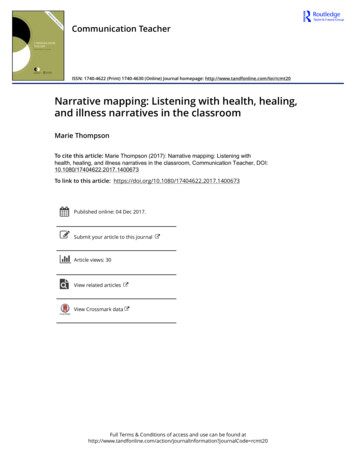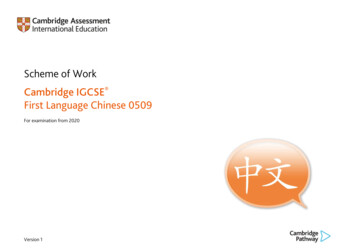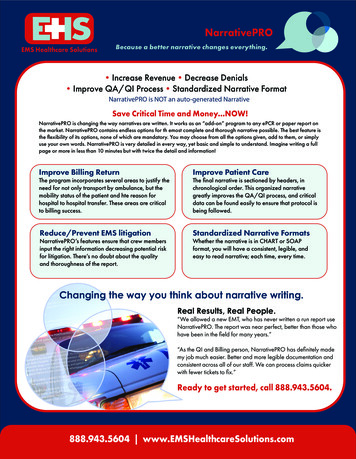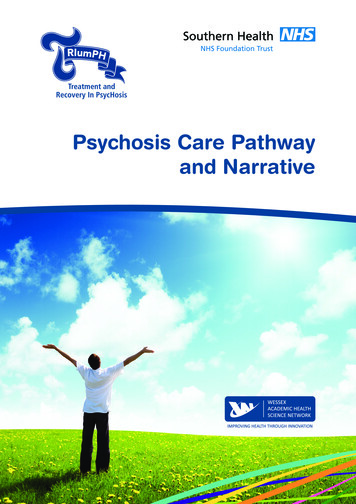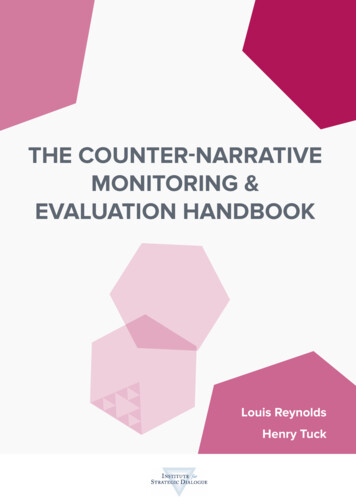
Transcription
The purpose of the performance narrative is to summarize the project activities and accomplishments forthe grant period.Grant Number: H47MC28479Project Title: Children’s Oral Healthcare Access ProgramOrganization Name: Colorado Department of Public Health and EnvironmentPrimary Contact Information:Name: Ashleigh KirkTitle: Perinatal and Youth Oral Health ManagerPhone: 303.691.4907Email: ashleigh.kirk@state.co.usPerformance NarrativeI.PROGRESSDefinitionsCDPHECO MDICF3HCPFOHURAEColorado Department of Public Health and EnvironmentColorado Medical Dental Integration (grant through Delta Dental of Colorado)Cavity Free at Three ProgramHealth Care Policy and FinanceOral Health UnitRegional Accountable EntityIn the last four years of the grant period, Colorado has made promising progress toward the long-term goalto increase the proportion of pregnant women in Colorado who receive oral health care. The Colorado teamutilized the PIOHQI approach to develop, test, refine, and spread a model of best practices across sixdifferent clinical sites in three unique health care systems. Preliminary results indicate that implementing amodel of education, screening, and referral into prenatal care results in approximately four times as manypatients receiving oral care during pregnancy (see Evaluation section). The general response has beenoverwhelmingly positive, and the Colorado team looks forward to continuing this work.The long-term goal to increase the percentage of infants who receive preventive oral health care has beenthe core of Cavity Free at Three (CF3) program work since the program’s inception. Recent evidenceshows that significant progress has been made. Results from the 2016-2017 Basic Screening Survey (BSS)showed that fewer Colorado children have cavities than they did 10 years ago when the program wasfounded. The percentage of infants who were less than a year old and received a dental service from anyprovider type billed through Medicaid, more than doubled from 2009 to 2017 (approximately 4 to 10%). In2017, about one third of 0-2 year olds covered by Medicaid received a dental service. Nevertheless, there isstill much work to be done. Exciting new developments in the Colorado landscape, specifically in regard toMedicaid Managed Care incentives and phase 2 of the state’s Accountable Care Collaborative (ACC), offernew opportunities to expand this work even more broadly.Over the course of the grant, key personnel offered continuity to the project even as other staff turnoverproved challenging. The Dental Director has lead the CF3 program in policy and state-wide strategy andserved throughout the grant as the Network Liaison. The Data/Evaluation Specialist supervisor has beenconsistent, even though staff beneath her have rotated on and off the project. Finally, the CF3 coordinatorand quality improvement specialist who took the task of managing the prenatal learning laboratories joinedin early 2016 and continues in that role. The CF3 supervisor who originally began PIOHQI, possessed awealth of knowledge from her dental background and many years with the program, while her recentreplacement offers the program new leadership and direction.The project team has also benefited from the expertise of the CF3 Advisory Board, other staff, oral healthexperts, and partners on an ad hoc basis.1
a. PIOHQI Expansion Project Advisory BoardThe goal of the CF3 advisory board is to offer an array of perspectives, expertise, and communityconnections to advise the program and develop strategic partnerships. Members include individuals whohave been involved in the Cavity Free at Three project since its inception 10 years ago to those in theperinatal community with whom CF3 team has recently formed relationships.Although not without its initial growing pains, the Advisory Board has proven a valuable addition to givedirection and broader reach to the CF3 program. This board was formed as a directive of the PIOHQI grant,yet will continue to meet and advise the program for the foreseeable future. As a testament to its success,advisory board members were key in establishing relationships with 5 out of 6 of the learning laboratoryclinical sites. Additionally an advisory board member made the initial introduction to the MedicaidManaged Care organization in the metro Denver area. As a result, CF3 is serving as a main point of contactfor primary care pediatric sites interested in addressing the dental key performance indicator (KPI) for newMedicaid incentive payments as part of phase 2 of the ACC. Among other things, the advisory boardmembers have also validated the strategic direction of the program while also encouraging the program tobranch into new spaces to promote child oral health. They have supported goals around oral health policyinitiatives, helped the program keep a pulse on other oral health initiatives in the state, and voted to revisethe CF3 Caries Risk Assessment.Members of the board include the former CDC Division of Oral Health Interim Director Dr. WilliamBailey; the American Academy of Pediatric Regional Representative and CF3 External Evaluator Dr.Patricia Braun; the Dental Outreach Coordinator from the Colorado Department of Health Care Policy andFinancing; the Director of Colorado’s Head Start Collaboration Office; the Vice President of Planning andEvaluation from a major Health foundation and other influential partners.b. Accomplishments and Progress to the Statewide PlanBelow are the activities that have led to the accomplishments and improvements achieved during the grantperiod as they relate to the state work plan and objectives.Objective A: By July 31, 2019, Colorado Department of Public Health and Environment (CDPHE)will expand access to direct oral health services for pregnant women and young children (birth to agefive).A-1: Conduct a community assessment to examine oral health access within Colorado.This activity was completed. Program staff continue to update and monitor these data to understandprogram impacts in communities that CF3 serves and to target state counties most in need of oral healthservices for infants, toddlers and pregnant women. Data is collected and visualized in a dashboard usingTableau software. Results of this assessment are continually disseminated to partners, with a focus on MCHand local public health agency partners, and with the goal of including these data in other assessment andplanning processes.A-3: Support the identified health systems through the provision of technical assistance and qualityimprovement to expand capacity that decreases access barriers for oral health services.Throughout the grant period, CF3 has collaborated with other organizations that are also working to expandaccess to direct oral health services for at risk children and pregnant women. These Colorado initiatives arepositively impacting their projects by leveraging the efforts of CF3. With these partnerships, CF3 is able tosupport oral health service delivery and access to care while minimizing duplicative efforts. Examples ofpartner state initiatives include: Delta Dental of Colorado Foundation: Colorado Medical/Dental Integration (CO MDI) projectDentaQuest Foundation’s Medical ORal Expanded care (MORE) project through Colorado RuralHealth CenterDelta Dental of Colorado Foundation: Colorado Medical/Dental Integration (CO MDI) project. CO MDIintegrates dental hygienists into primary care medical settings and school-based health centers. The project2
aims to reach children who have limited access to dental care due to location, insurance status, as well astransportation issues and includes a few sites expanding their reach to include pregnant patients. All 16previously awarded sites have completed a CF3 training. To further nurture collaboration, the foundation’sproject officer serves on the CF3 Advisory Board. In 2018, 10 new organizations were awarded CO MDIgrants to begin a second wave of grantees. For this new wave, CF3 is taking a different approach. The CF3team is training the integrated hygienists embedded within sites to become certified CF3 Master Trainersand serve the ongoing training needs within that integrated health system. CF3 is hopeful that this newmodel of embedded Master Trainers increases the sustainability of the CF3 program, and builds on thepartnership with CO MDI and the natural role the integrated hygienist plays as an oral health champion inthat organization. During this reporting, one health system (Melissa Memorial Hospital) received a CF3training, and 5 integrated hygienists have been trained as certified Master Trainers. Plans for additionaltrainings are in place for the end of June 2019.Additionally, CO MDI has served as an important partner in the prenatal learning laboratories. It wasthrough a partnership at the first learning laboratory with Denver Health Eastside Clinic that our programwas able to leverage the integrated dental hygienist as a natural champion. While waiting for her operatoryequipment from the CO MDI grant to arrive, the hygienist played a leadership role in testing new andimproved care processes between the co-located medical and dental clinics. After she began seeingpatients, she continued in this role and provided permanent built-in dental capacity to prioritize pregnantpatients. Her ongoing position will ensure the sustainability of the learning laboratory goals well beyondthe grant period.After serving as a learning laboratory for approximately a year, Denver Health Westside Clinic applied andreceived the same grant to receive a CO MDI hygienist. The integrated hygienist at this site began seeingpatients in January 2019 with an exclusive focus on serving pregnant women. Her supervisor is the sameprenatal nurse manager that implemented the learning laboratory system changes at Eastside. This is atestament to the impact the learning laboratory had on the supervisor who decided to seek additional waysto support dental access for patients at the second clinic she supervises.Colorado Rural Health Center: Medical ORal Expanded Care (MORE Care) ProjectAs previously reported, DentaQuest Institute awarded Colorado Rural Health Center (CRHC) grant fundingto implement MORE Care. The project aims to provide primary and secondary preventive oral healthservices in primary care medical offices to underserved populations in rural Colorado. CRHC staff workwith each of the five grantee clinics to coach quality improvement methodology and effectively implementstrategies into clinic processes, such as scheduling, workflow, and EMR implementation. CRHC leveragedCF3 expertise as part of their MORE Care project and specifically requested CF3 provide clinical trainingto providers and staff at the three MORE Care clinic pilot sites. The CF3 Education Coordinator served onthe project advisory group to share valuable information and facilitate program success. Unfortunately,funding for the MORE Care project was not renewed and difficulties around CRHC’s ability to bill fordental services makes continuation of the project a challenge. The project remains unfunded and inactive asof July 2018.A-4: Offer continuous training, technical assistance, quality improvement, and resources to health systems,health care providers, and oral health advocates.Technical AssistanceAs previously reported, Freshdesk is an online customer support helpdesk that allows CF3 staff tostreamline technical assistance and training needs. This helpdesk allows the CF3 team to collaborate,resolve issues, categorize and prioritize needs, and run reports on several metrics.During this last period of grant, CF3 staff processed 69 requests. The top two ticket field categories weretraining requests (n 35, 51%), and billing (n 6, 9%). There were also many tickets labeled “other” (n 18,26%) that included: questions about becoming a Master Trainer and how to get involved.Throughout the grant period, CF3 staff continued to improve implementation of oral health services byimproving the technical assistance the CF3 team offers. The CF3 team used the Freshdesk platform to3
understand the barriers our partners experience and address these accordingly. This led to the decision toprovide specific billing guidance and help with all the details around implementation for practice managerstaff.From conversations with CF3 partners, it has been reported that more private insurance carriers are nowreimbursing for the fluoride varnish application alone using the CPT code. Although not as generous areimbursement as the Medicaid CDT codes that include reimbursement for the screening/risk assessmentand counseling of caregiver for children under age 3, this is still a major win as this has been a reportedbarrier in the past. Specifically, many practices complained that because private insurers were notconsistent in reimbursing oral health services in the medical setting, the Cavity Free at Three model did notmake sense in a practice with mixed payer sources. Thus the CF3 team has taken steps to alert our partnersof this new development. The hope is that it will result in greater uptake of the model, more universalapplication of oral health services for all children, and greater sustainability overall. With a change ingovernor in Colorado, there are also potential opportunities in the new administration's strategic plan topossibly include state enforcement of commercial medical coverage for oral health services up to age five(currently required under state and federal law).CommunicationDuring the duration of this grant the CF3 team has enlisted the CDPHE communications unit expertise. Thesection below highlights areas of progress.CF3 Updated Materials and Branded LookWith the help of communications, CF3 program updated the patient-facing materials provided to clinics aspart of CF3 training. This included pamphlets covering child and prenatal oral health at an appropriatereading level, with a new modern branded design and look. These materials have proven especially helpfulfor the prenatal learning laboratories, included in the prenatal information packets given to each expectingmother. Staff at the learning labs report high satisfaction with being able to reference the brightly coloredsheets which have oral health information clearly laid out as part of their prenatal education.CF3 NewsletterSince 2016, CF3 has distributed fourteen quarterly, electronic newsletters to partners and individuals whohave attended program trainings. With help from communications, the CF3 program updated the look andfeel of the newsletter to provide seamless communication with relevant topic areas newsletter recipientscould expect to see each time. Topic areas included new and relevant research updates related to perinataland children’s oral health, program updates and changes, billing updates and changes, partnercommunications, grant opportunities, training opportunities and other need-to-know topics related toperinatal and children’s oral health in the state of Colorado.The newsletter was sent to everyone who had been trained in CF3 including healthcare students andproviders, partners and stakeholders of CF3 and oral health advocates in Colorado. The CF3 programtracked the open rate of the newsletters and would evaluate the content that had higher open rates.Recipients would click on research and billing updates most frequently. Training and grant opportunitiestended to have a slightly lower click-rate. Partner communications and program updates (staffing changesand job opportunities) tended to have lower click-rates.CF3 WebsiteAs previously reported, an update was completed in January 2018 to improve the ease-of-use of the CF3website. Specifically, the update made the website more mobile-friendly; added a resource filter for users tobetter search and filter through resources; updated the Medicaid Calculator tool to project how Medicaidreimbursements may affect a dental practice’s income; re-organized tabs to better direct diverse users to getthe information they need; and added a Google analytics account to track website usage and better tailor itto users' needs.Between August 1, 2018 and May 19th, 2019, there have been 2,642 users, with 2,611 new users and 3,388sessions. The home tab received the most views (n 2,707, 35%) Resource tab in second (n 1,884, 24%)4
followed by How To Implement (n 707, 9%). The number of users and sessions has continued to grow ascompared to the last reporting period (2,642 compared to 1,527 users last reporting period).This increase in website traffic supports the hypothesis that the improvements in user interfaces, such asbecoming mobile-friendly and improving readability and searchability of the site, would increase the abilityfor partners to find and use CF3 resources. Colorado plans to continue to use the website as a tool to boostpartner engagement and CF3 implementation sustainability.A-5 Increase the number of primary care medical and dental professionals in identified health systems whocan provide oral health education and services for pregnant women and young children.During the lifetime of the grant (2015-present) CF3 provided trainings to 2,103 individuals. Of thoseindividuals: Total medical providers: 378 Total dental providers: 245A-6 Increase the number of health professional students trained in CF3 that results in increased workforcereadiness. Identify the proportion of students who implement the CF3 model into their practices.During the lifetime of the grant (2015-present) a total of 738 students were trained in the CF3 model. Aspreviously reported, it was not feasible to track the proportion of students who implement the CF3 modelinto their practices due to a variety of reasons including difficulty tracking those students over time(response rates and contact information), a good proportion of students practicing out of state, and the lowlocus of control many students have when first practicing as health professionals in a new practice. Duringthe grant period the CF3 Advisory Board members advised the CF3 team to not expend resources andenergy in this objective but rather to focus on other opportunities for supporting sustainableimplementation.A-7 Collaborate with Colorado’s Primary Care Office to train new Colorado Health Service Corps andDental Loan Repayment Program loan recipients in CF3 that results in increased workforce readiness.Colorado primary care providers working in designated health professional shortage areas can receivefunding to repay qualifying educational loans. CDPHE’s Primary Care Office (PCO) manages both theColorado Health Service Corps (CHSC) and the Dental Loan Repayment Program (DLRP). The contractedhealth care professionals serve high-risk populations, making them ideal candidates for CF3 training.As previously reported, all new loan repayment awardees receive CF3 information in their “WelcomeEmail” and are added to the CF3 newsletter distribution list. In addition, CF3 training information isincluded in PCO’s quarterly newsletter, which is distributed to approximately 1,500 individuals. CF3collaborated with PCO to present to student groups together to promote workforce readiness and helpproviders identify opportunities to work in communities with a shortage of providers. CF3 will continue towork with PCO on presenting a newly developed curriculum (previously reported) to dental hygieneprograms.As an example of our collaboration, a CF3 partner recently reported that one of their only dental providerswho take Medicaid had stopped accepting new patients. PCO manager offered to reach out to dentalproviders in the area and provider information on dental loan repayment plans as the area was a healthprofessional shortage area.Colorado Health Service Corps (CHSC)CHSC awardees deliver primary health care services in a public or nonprofit clinic that accept publicinsurance and offer discounted services to low-income, uninsured patients on a sliding fee scale. The5
Colorado Health Service Corps uses HRSA state loan repayment program funds as match funds for loanrepayment awards.Currently, CHSC maintains 333 active contracts of which 53 contracts are with oral health providers or16.4% of total program field strength. There are active contracts with 34 DDS/DMD and 19 RDHs.Dental Loan Repayment Program (DLRP)Eligible DLRP providers include general dentists, pediatric dentists and dental hygienists. The providersmust work in a public, nonprofit, or private dental practice in Colorado and serve some patients receivingpublic insurance and/or who are uninsured. Applicants are ranked on a scale from 0-100, with seven pointsgranted to applicants who have completed CF3 training. The DLRP manager validates CF3 trainingparticipation with the CF3 program’s training participants report spreadsheet. Currently there were activecontracts with 39 DDS/DMD and 4 RDH, 25 of which are CF3 trained.National Health Service Corps (NHSC)NHSC physicians and dentists commit to providing primary health care in the HPSAs with the greatestneed. Currently there were 173 NHSC clinicians practicing in Colorado. Of this active field strength, 36are dental clinicians (20 DDS/DMD, 16 RDH), 11 of which are CF3 trained.Objective B: By July 31, 2019, CDPHE will increase delivery of best practices of oral health care forpregnant women and young children (birth to age five).B-1 Utilize QI processes to make rapid and incremental changes to revise CF3 training curriculum toincorporate: more engaging materials and presentation methods; current best practices for deliveringculturally appropriate oral health services; current best evidence-based practices; and information aboutfacilitators and barriers to the CF3 intervention.During the lifetime of the grant, the CF3 team has learned significantly from PIOHQI approach. Theresources and training provided by Frameshift group and others have guided the CF3 team to systematicallyidentify areas for improvement (root cause of the problem), and test solutions on a small scale to determinewhat leads to improvement. The CF3 team has adopted the use of specific tools to help follow thisapproach both for internal improvements and work with our stakeholders. For example, the Before ActionReview and After Action Review (BAR/AAR) is a tool useful for being explicit about intended results. Thequestions in the guide prompt thought about what intended results will look like and the underlyingassumptions held about how to get there. The tool also encourages important reflection on what actuallycaused the results, and on what to sustain or improve in the future. It has guided the CF3 team oneverything from how to improve the quality of our meetings, to updating the CF3 curriculum, and makingbetter use of CF3 Advisory Board members.As an example of how the CF3 team uses the PIOHQI approach to continually evaluate program andprocesses, in May 2019 the CF3 team spent a half day of dedicated time to QI for program evaluation andimprovement. This included completion of a SWOT analysis and a customer journey mapping exercise toevaluate the communication tools and processes used when scheduling a training and providing technicalassistance to pediatric medical practices. As a result, the CF3 team plans to make specific improvements toimprove customer experience, follow-up and the sustainability of implementing preventive oral healthservices in this setting. This includes 1) updating CF3 readiness assessment, 2) development of charter oragreement to implement if a clinic/practice requests training, 3) setting the expectation for additional followup contact with CF3 team after training to monitor implementation, and 4) providing a menu ofQI/Technical Assistance options that a CF3 team member can provide to clinic needing additional help.B-2 Administer and manage a system to evaluate the impact of CF3 training on providers’ behaviors andpractices.CF3 Evaluation Data CollectionAs previously reported, the CF3 evaluation includes a pretest that collects robust baseline data abouttraining participants’ current delivery of eight oral health services in their practices and their demographic6
information, and follows up with a post-test to measure the impact the training had on the trainees’behaviors and practices (See Evaluation Section). CF3 has been collecting pre/post data since July 2015.The most recent post-test data analysis is still from September 30, 2017 due to low response rates fromproviders. This portion of the CF3 evaluation will be discussed and revamped in the future to reflect thechanges outlined in processes discussed in B-1 section above.Between July 1, 2015-September 30, 2017, 693 medical/dental providers and medical/dental assistantsreceived the post-test survey and 195 have fully completed the post-test survey, for a 28% response rate(correction of statement and response rate). To date, results suggest that CF3 training is positivelyimpacting providers and staff oral health practices and behaviors. Please see the Evaluation Section III formore detailed results.QI Laboratory Data CollectionSurvey DataDuring the lifetime of the grant, four QI laboratory sites were surveyed to collect provider knowledge andbeliefs about providing oral health services to pregnant patients and to gather information to guide clinicalquality improvement efforts. These include: Denver Health Westside, Denver Health Eastside, andUniversity Nurse Midwives (UNM) and Center For Midwifery (CFM) Clinics (the former two both CUCollege of Nursing midwifery clinics).The CF3 team has learned that sharing this information back to leadership in a digestible format has hadgreat success. Typically the format has been a one page data snapshot and/or a powerpoint presentation. Aspreviously reported, data from one summary gave leadership demonstrable data that there was a need tocontinue to improve provider knowledge on the safety of oral health services through continued education.This led to an informal policy to onboard all new staff with Smiles for Life online modules.In December 2018, the CF3 team held a kickoff meeting to launch learning laboratories at the CU collegeof nursing midwifery clinics (both UNM and CFM). The pre-test of knowledge and belief about providingoral health services to pregnant patients was administered prior to the staff completing recommendedtraining and receiving guidance around the project. The data was very telling of the for training, with only10% of Certified Nurse Midwives reporting they were confident in their training to provide oral healthservices to pregnant patients and 90% reporting the current level of care coordination between their officeand the dental providers as poor or fair. See the data snapshot (Attachment 5). The final post survey for allfour sites will be administered at the end of June 2019 and the CF3 team plans to report these data back tosites in a similar fashion.Clinical Billing DataDuring the lifetime of the grant, data was collected from the two co-located medical/dental learninglaboratories using billing codes to track percent of pregnant patients that actually received oral healthservices within the same system (see Evaluation Section III and Attachment 2).Three years of data were pulled for baseline data, and then monthly data tracked during the course of theproject. Generally, it was observed that four times as many patients received dental services duringpregnancy compared to baseline when a QI approach was used to implement education, screening anddental referral processes in the prenatal office (start date for two clinics varies, see Evaluation Section IIIAttachment 2).Other stand-alone medical sites tracked the proportion of prenatal patients screened using the CF3 prenataloral health risk assessment tool the CF3 team developed (previously reported) as well as the number ofdental referrals completed for those screened. UNM and CFW, who were trained in December 2018 androlled out new processes in January 2019, have already improved their screening rate by threefold, reaching36% and 33% respectively in May 2019 (up from 12% and 7% the first month of data collection). Thesenumbers are believed to underreport screening and referral rates as midwives continue to forget to add thediagnosis code which facilitates pulling the data.B-3: Collaborate with the state Medicaid agency to require primary care providers be educated andcertified in order to be reimbursed for oral health services by Medicaid & CHP .7
As previously reported, this policy has not changed. Oral Health Unit staff continue to monitorDentaQuest’s Office Reference Manual updates and Medicaid Provider Bulletins to ensure accurate policydocumentation.B-4 Identify and use strategic partnerships to increase the communication, collaboration and learningabout oral health issues among medical, dental and public health professionals, and oral health advocates.Internal PartnersCF3 has established itself as a viable program within CDPHE and earned the reputation as the state’sauthority on preventive oral health for young children and pregnant women. CF3 staff participate in severalCDPHE internal work groups and meetings. These include (but are not limited to):Oral Health Unit (OHU) CF3 is administered in the Oral Health Unit. Program staff continue to consultwith the state fluoridation expert to address community barriers related to community water fluoridationand provider questions.Maternal Child Health (MCH) CF3 remains engaged in MCH work groups despite that oral health wasdropped from MCH state priorities in 2015. CF3 staff serve as subject matter experts to CDPHE,Prevention Services Division, MCH and related programs and consult with MCH to align messaging. Bycontinuing to attend these meetings, including the Perinatal Workgroup, and building relationships withprevention partners, CF3 staff has been able to increase communications and alignment of best practices.One example of alignment across internal programs
A-4: Offer continuous training, technical assistance, quality improvement, and resources to health systems, health care providers, and oral health advocates. Technical Assistance As previously reported, Freshdesk is an online customer support helpdesk that allows CF3 staff to streamline technical assistance and training needs.


